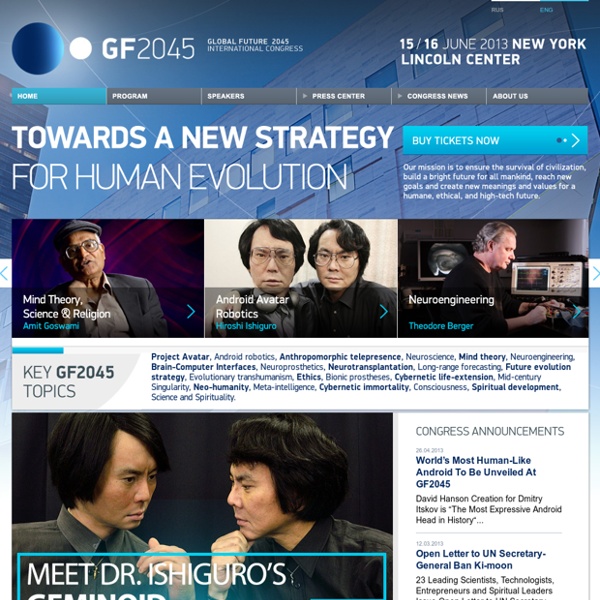



The World Future Council: WFC - Home Ray Kurzweil about GF2045 and 'Avatar' Founded by Russian entrepreneur Dmitry Itskov in February 2011 with the participation of leading Russian specialists in the field of neural interfaces, robotics, artificial organs and systems. The main goals of the 2045 Initiative: the creation and realization of a new strategy for the development of humanity which meets global civilization challenges; the creation of optimale conditions promoting the spiritual enlightenment of humanity; and the realization of a new futuristic reality based on 5 principles: high spirituality, high culture, high ethics, high science and high technologies. The main science mega-project of the 2045 Initiative aims to create technologies enabling the transfer of a individual’s personality to a more advanced non-biological carrier, and extending life, including to the point of immortality. A large-scale transformation of humanity, comparable to some of the major spiritual and sci-tech revolutions in history, will require a new strategy.
Metaphilosophy – David Chalmers Philosophical Studies 171:535-44, 2014. In December 2009, David Bourget and I did a survey of professional philosophers, asking for their views on thirty philosophical questions. There were many interesting results. Philosophy 1:3-31, 2015. Philosophical Review 120:515-66, 2011. In (Chalmers, Manley, and Wasserman, eds.) My remarks at the memorial service for David Lewis at Princeton University on February 8, 2002 . Welcome to WFSF The International Flag of Planet Earth The scientific study of flags is called vexillology, and the practice of designing flags is called vexillography. Both of these are an outcome of heraldry. In these practices there are different unofficial design rules/costums, about colors, placement, proportions, typography, and aestethics in general. This proposal is accurate according to the regulations regarding flags. Centered in the flag, seven rings form a flower – a symbol of the life on Earth. Centered on an azure field, seven circles of silver interlaced, creating a flower.
SUSAN SCHNEIDER - Susan Schneider-Philosophy/AI | DaVinci Institute The Amazing Rise of the Mandela Effect! 13th August 2016 By Cynthia Sue Larson Guest writer for Wake Up World The Mandela Effect: When History Just Won’t Stay Put The phrase “Mandela Effect” has been trending upward at an exponential rate since July 2015, according to Google Trends. While many are surprised by the recent surge of interest in the “Mandela Effect,” those of us who have been researching and writing about this phenomenon of reality shifts and alternate histories have long been anticipating just such a rise of interest. What is the Mandela Effect? The “Mandela Effect” is named after South African anti-apartheid revolutionary Nelson Mandela, who became a topic of interest in the year 2010 by people noticing with surprise that he was alive at that time – since many people remembered him having died while incarcerated. The Mandela Effect is one of those things most people won’t believe in until it happens to them. I’ve been researching this phenomena since the 1990s. Finding Evidence of Many Worlds in Alternate Histories
The Brain Preservation Foundation Club of Amsterdam - Shaping Your Future in the Knowledge Society